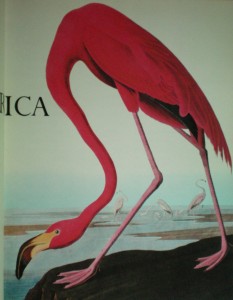 Towards the end of last year, 66-year old British book dealer Michael Tollemache, spent 11.5 million US dollars for a complete set of John James Audubon’s “Birds of America.” A new price record for the sale of a rare book was set as a result. The four-volume, double-elephant sized book was painted by naturalist Audubon between 1827 and 1838. They contained 435 life-size bird engravings. “I intend to enjoy it for however long I am able to enjoy it”, Tollemache said in a phone interview. He did not rule out the possibility of a resale. After all, he is a dealer.
Towards the end of last year, 66-year old British book dealer Michael Tollemache, spent 11.5 million US dollars for a complete set of John James Audubon’s “Birds of America.” A new price record for the sale of a rare book was set as a result. The four-volume, double-elephant sized book was painted by naturalist Audubon between 1827 and 1838. They contained 435 life-size bird engravings. “I intend to enjoy it for however long I am able to enjoy it”, Tollemache said in a phone interview. He did not rule out the possibility of a resale. After all, he is a dealer.
11.5 million US dollars for four volumes is a lot of money any way you look at it. Did he actually get a bad deal? Maybe. Auctions are known to promote exuberance in spending and attain higher pricing for collectors’ items having significant interest, while in other cases expose bargains that are considered great buys at discounted prices. Which end of the scale did Mr. Tollemache’s purchase end up in?
During the period of 1824 through 1838, when John James Audubon, observed and painted the avian natural world, he made his engravings available to subscribers, who in turn would bind them into a book. As a result of this format, the number of complete sets created and seemingly available for sale is quite scarce. A full set would have cost about 1,000 US dollars back when it was first printed. Today, individual plates sell for thousands of dollars, and a full collection sold for 8.8 million US dollars in 2000. Assuming the volumes which sold in 2000 and the ones which sold in 2010 were quite similar, it would be reasonable to conclude that within a decade the value of the “Birds of America” had appreciated by approximately 30%. How does such price appreciation compare to other collectibles during the same period? Here is some comparative data:
Total Return
Dow Jones Industrial average 39%
Standard and Poor 500 17%
Nasdaq 18% i
Precious Metals 365%
Commodities 176% ii
i Total shareholder return Dec 2000 – Dec 2010 source Bloomberg
ii Source Datastream, Lloyds TSB
Interestingly enough the answer to the question “bad deal good deal,” lies in the category that rare book collections fall under. Is a book more like a commodity or a common stock? I am not sure about you but I always thought of a rare book as more of a piece of work, an artistic project, a human sacrifice, a unique part of human nature. This rare book, of course, being a collection of rare art can very well be categorized as such. While contemporary and modern art had appreciated nicely during the decade, 18th century art did not. Also, is art in a book format less desirable than a painting or wall art? It definitely needs to be factored in if it is by any means less attractive. The appeal of a complete set is also important and I am probably neglecting to include a number of other considerations that should participate in a comparative analysis of this kind.
Can we then deduct with the information presented with certainty that Mr. Tollemache’s deal was a good investment? It definitely looks that way from an art collector’s lens given the nominal markup in price paid, especially when compared to the appreciation of tangible assets and the mediocre performance of the US stock market during the last decade. There is also another school of thought, wearing a different kind of lens, however. The skeptics would suggest that for a conclusive answer we may have to more appropriately check again in 2020 or sometime into the future. In the meantime, I would be interested in finding out what you all think.
{ 1 comment… read it below or add one }
Interesting analysis. I wonder how the “double elephant folio” that sold for $400,000 in 1977 compares to the other two sales mentioned here. Was that a complete set?
{ 3 trackbacks }